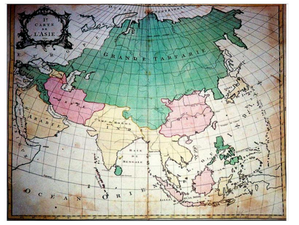 by M.P. Pellicer | Stranger Than Fiction Stories Tartary is the historical name for Siberia and Central Asia. There has always been a persistent rumor of a hidden past.  The main waiting room of old Penn Station c.1911 (Source - Museum of the City of New York) The main waiting room of old Penn Station c.1911 (Source - Museum of the City of New York) The Tartarian Empire was thought to be a lost civilization that enjoyed advanced technology and culture to go with it. This covered the area of Afghanistan, Kazakhstan, Mongolia, China and the Russian Far East (Chinese Tartary). Tartaria is supposed to be the "real name for Russia." The theory proposes that demolished buildings such as the Singer Building, the original New York Penn Station erected in 1910, or the buildings from the 1915's World Fair were in actuality structures copied from an empire in Tartary that was suppressed from history. The mansions built during the Gilded Age are also supposed to have been Tartarian-inspired. Other buildings that supposedly originate in Tartaria are the Pyramids in Egypt and The Great Wall of China. These monuments were too massive to be destroyed. Others were destroyed on purpose to hide Tartarian history.  Women of northern Tartary, by Grueber c.1749 Women of northern Tartary, by Grueber c.1749 The end of the Tartarian Empire came about after a "mud flood" depopulated vast swaths of the world, and that only architectural elements were left behind. Many of the historical buildings destroyed during WWI and WWII were also thought to have been examples of Tartarian styles. The proponents of the theory say once this advanced and huge civilization dominated the earth's surface. Two hundred years ago the flood destroyed these people and most of the buildings, but it was covered up. The argument asks: have you walked through a major city where the oldest building are located? They all have high ceilings, and basement windows cut in half by the ground. These proportions were calculated for a giant race known as the Tartarians. 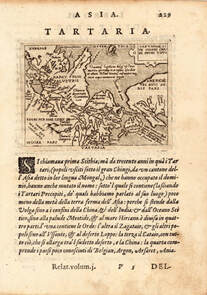 Tartaria map and description by Giovanni Botero from his "Relatione universali" (Brescia, 1599) Tartaria map and description by Giovanni Botero from his "Relatione universali" (Brescia, 1599) Great Tartary (Latin: Tartaia Magna) was the named used by for the area of the Great Steppe by Europeans from the Middle Ages to the 20th century. From Encyclopedia Britannica, first edition, Volume 3, Edinburgh, 1771, p. 887: "Tartaria, a huge country in the northern part of Asia, bordering Siberia in the north and west, called the Great Tartary. Tartars living south of Muscovy and Siberia are called Astrakhan, Cherkasy and Dagestan, living in the north-west of the Caspian Sea, called Kalmyk Tartar and which occupy the territory between Siberia and the Caspian Sea; Uzbek Tartar and Mongols, who live north of Persia and India, and finally Tibetan, living to the north-west from China." Tartary was often divided into sections with prefixes denoting the name of the ruling power or the geographical location: Thus, western Siberia was Muscovite or Russian Tartary, Xinjiang and Mongolia were Chinese or Cathay Tartary, western Turkestan (later Russian Turkestan) was known as Independent Tartary, and Manchuria was East Tartary. As the Russian Empire expanded eastward and more of Tartary became known to Europeans, the term fell into disuse. Tartary never existed as a formal political state, but was the ancient part of a Mongol state created by Genghis Khan. European areas north of the Black Sea inhabited by Turkic peoples were known as Little Tartary. Marked on the map are Catay (Cathay), Kalmouques, Usbeck, Turquestan, Perse, Niulan, Yupi, Tibet (and Lassa/Lhasa). 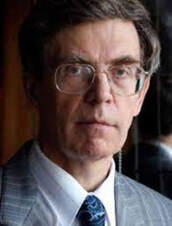 Anatoly Fomenko Anatoly Fomenko The chief author of this theory is Anatoly Timofeevich Fomenko born March 13, 1945, in Donetsk, Ukraine. He is a professor at Moscow State University, a member of the Russian Academy of Sciences, the Russian Academy of Natural Sciences and a well-known topologist, with specialization in geometry. He has served as the editor of several Russian-language mathematics journals. His father was an industrial engineer, and his mother a philologist and a teacher of Russian language and literature. He authored the concept of the New Chronology. In it he claims that many dates given to historical events are not mathematically accurate even to the days of the Roman Empire and Greece. He proposes that these events occurred in the Middle Ages (5th to 15th century A.D.), and that all of Chinese and Arab history are fabrications of 17th and 18th century Jesuits. Jesus Christ lived during the 12th century A.D. and was crucified on Joshua's Hill located on the shore of the Bosporus in Istanbul, Turkey, according to Fomenko's timeline. The Trojan War and the Crusades were the same event, and Genghis Khan and the Mongols were Russian. The land west of the original American colonies were the far eastern part of the "Siberian-American Empire" prior to its disintegration in 1775.  New Chronology books by Anatoly Fomenko New Chronology books by Anatoly Fomenko He contests dating methods using dendrochronology, which uses tree rings to tell the exact year they were formed, and radio carbon dating. According to Dr. Fomenko "Tartars and Mongols" were the ancestors of modern Russians, who lived in a trilingual state with Arabics and Turks. This version removes Genghis Khan, Tamerlane and Alexander the Great from Russian history. The ancient Russian state was governed by civil and military authorities, and the hordes were professional armies who were conscripted for life. They were recruited by "blood tax", and they invaded regions that didn't pay their taxes. Fomenko claims official Russian history was forged by German scholars brought to Russia by the Romanovs, who he classified as usurpers who ascended the throne through a conspiracy. The purpose of the imported German historians was to make the Romanov's rule appear legitimate. He dated the ancient civilizations of Rome and Greece to the 14th century A.D. The Giza pyramids and ancient Egypt are dated to the span from the 11th to 14th century A.D., and were identified as the royal cemetery of the Global "Mongolian" Empire. He deciphered the ancient Egyptian horoscope cut in stone that hangs in the main entrance to the Louvre museum. He said all dates on it are medieval, and coincide with eclipses. He said there was no ancient history of China, with the so-called Ancient Chinese history being datable to the 17th and 18th century. It was made-up ancient European history reworked and transcribed. Islam and its key figures appeared in the late 15th-16th century A.D. as a branch of proto-Christianity. According to Fomenko the Hagia Sophia is the Temple of Solomon. The Stone of Qa'Aba in Mecca contains the lost Ark of the Covenant. 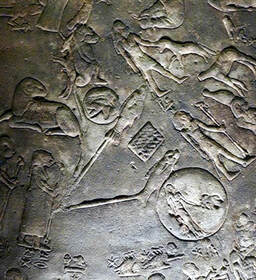 Dendera Zodiac carvings found when Napoleon visited in Egypt in 1799 Dendera Zodiac carvings found when Napoleon visited in Egypt in 1799 In 1799, when Napoleon visited Egypt a circular zodiac was found carved into the ceiling of The Temple of Hathor, located in the village of Dendera. It is the only circular astronomical depiction by the Egyptians. It depicts 360 days of the Egyptian year, with 36 decans spread evenly among 12 zodiacal constellations. French scholars of the day believed the carving was thousands of years older than the Biblical date of creation. This caused consternation in the church until Jean-Francois Champollion who was the first to decipher the Rosetta Stone, rectified the zodiac's date of creation using cartouches adjacent to the carvings. The stone zodiac was taken to France in 1821 when engineer Jean LeLorrain broke it from the ceiling of the temple using explosives. According to Fomenko none of the dates given for the Dendera Zodiac are accurate. 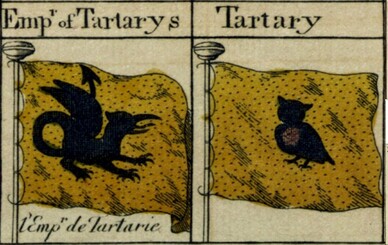 Flag of Tartary Flag of Tartary Fomenko dates religions as pre-Christian (before the 11th century and Jesus Christ), Bacchic Christianity (11th to 12th century, before and after Jesus Christ), Jesus Christ Christianity (12th to 14th century) and its subsequent mutations (15th to 17th) into Orthodox Christianity, Catholicism, Protestantism, Islam, Buddhism, etc. Fomenko is not the only one that has posited that written history is not accurate. There is The Phantom Time Hypothesis where 300 years of European history is completely made up. The time period affected is 615 to 911 A.D. which were fabricated by the Catholic Church. This theory was developed in 1994, by German historian Heribert Illig in a paper titled The Invented Middle Ages: The Greatest Forgery in History. In it he describes where Byzantine Emperor Constantine VII, Holy Roman Emperor Otto III and Sylvester II, the pope during those years colluded to fabricate history in order to pay for papers that would support their political aspirations. Sylvester II had once been known as Gerbert of Aurillac, mentor to Otto III. The conspiracy entailed that manipulation of the Ano Domini calendar where Otto III's reign began close to 1000 A.D., which became the jumping off point for a new Christian millennium. However this required that 297 years had to be falsely chronicled to fit into this new timeline. If this were true, in reality these three men came to power in the middle or end of the 7th century A.D. but with this revision, it was made to appear the dates of their reigns was marked by the new millennium. Constantine VII on his part instructed monks and scribes to alter and rewrite pieces and texts in history books, and the Greek Maiuscula to fit the new version as well. Why he decided to help Otto III remains a mystery. Illig's theory describes where Pope Gregory XIII abandoned the Julian calendar in 1582, despite being in use since 45 B.C. In its stead, he used the Gregorian Calendar which is still used today. In order to have Easter fall on a correct date the Pope ordered his scribes to add 10 extra days to the calendar starting on October 15, 1582. Even though this change in the Gregorian calendar set it behind 13 days, according to Illig's calculations, 297 years disappeared from the overall history of Europe. 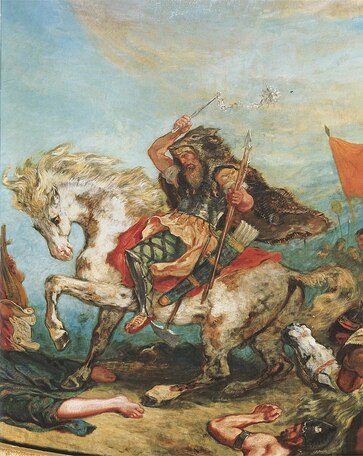 Attila the Hun riding a pale horse, by Eugène Delacroix (1798–1863) Attila the Hun riding a pale horse, by Eugène Delacroix (1798–1863) Illig points to the absence of archeological evidence from this time period, and that Roman architecture appeared long after Rome supposedly fell in 475 A.D. Fomenko's New Chronology is similar to Illig's theory. According to him, human history is based on a few individuals that were repeated or renamed with all containing similar origin stories. He used comparison of historical figures to prove his point. The most famous was the Kings of Israel (1040 B.C. - 44 A.D.) and the emperor of the late Western Roman Empire (300 - 476 A.D.). His research via statistical methods found strong correlations between the events and history faced by the rulers of these two time periods. These correlations were not found in other time periods. These assertions by Fomenko and Illig fly in the face of accepted Western history. Fomenko's hypothesis means that history started in 800 A.D., which means human history is only 1223 years old, and if the Phantom Time Hypothesis is applied to this timeline, 297 years are missing. Could this be why the world didn't end in 2012 as foretold by the Mayan calendar? If the years between 614 to 911 A.D. never occurred then historical figures from these years are also fabricated. This would include Charlemagne, Genghis Khan and Attila the Hun who were the same person, and renamed to fit into their respective eras. Attila ruled the Huns from 434 until 453. He was one the most feared enemies of the Western and Eastern Roman Empires. He plundered the Balkans, invaded Byzantine and crossed the Rhine and marched on Roman Gaul (modern France). He invaded Italy, and only his death stopped him from taking Rome. The tomb of Attila and the location of his capital have never been found. Genghis Khan (1162?-1227) founded the Mongol Empire, which conquered large swaths of China and Central Asia. He destroyed many cities and killed millions across Eastern Europe and Asia during his war campaigns. Modern historians have found it difficult to compile and understand the life of Genghis Khan supposedly because of linguistic dispersion. 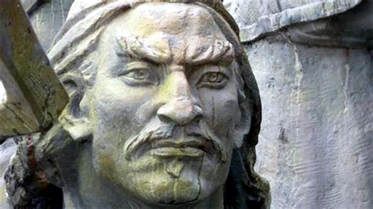 Genghis Khan Genghis Khan Illig used allegations of fraudulent documents being produced during the time of the 7th century. Supposedly Byzantine documents from this time period, which had been transcribed to another type of script were thrown away. Was this done to hide inconsistencies in these records? There is also the story of Charlemagne the first Holy Roman Emperor, a King Arthur-like figure. Regal but illiterate, who was both secular and religious. If there was another Holy Roman Emperor to improve on his reign, who better than someone like his predecessor that would be crowned on Christmas Day. Such is the story of Otto III who was crowned on Christmas Day 983 when he was three years old. Illig and Fomenko's theories could also be based on a deeper understanding of the Dark Ages, which are believed to have started at the end of the Roman Empire in 476 A.D. and continued up until 1500 A.D. These 1,000 years of feudalism, hardship and chaos came to an end with the beginning of the Renaissance and Columbus' discovery of the New World.  Orphan train in Kansas. The orphans would be adopted at the train stops. c.1900 (Source - Kansas State Historical Society) Orphan train in Kansas. The orphans would be adopted at the train stops. c.1900 (Source - Kansas State Historical Society) The fall of Tartaria has several theories, and one of them is what is known as a mudflood that occurred between the 1700s and the 1800s throughout the world. There are reports and pictures of buildings with ground-floor windows being partially covered up, and streets built on top of older one. An estimated quarter million children were orphaned and abandoned from 1854 to 1929. They were placed throughout the United States and Canada on the Orphan Train Movement. It is said many of these children were Tartarian orphans, and there is no explanation for this surge in homeless children. This event precipitated the foster program in the United States. Others date it back to the explosion of Krakatoa in 1680. The mystery of Tartaria and the possibility of an altered historic timeline remains as elusive and mysterious as ever.
0 Comments
Your comment will be posted after it is approved.
Leave a Reply. |
Stranger Than Fiction StoriesM.P. PellicerAuthor, Narrator and Producer Archives
July 2024
Categories
All
|
Stories of the Supernatural
- Stories of the Supernatural
- Miami Ghost Chronicles
- M.P. Pellicer | Author
- Stranger Than Fiction Stories
- Eerie News
- Supernatural Storytime
-
Astrology Today
- Tarot
- Horoscope
- Zodiac
-
Haunted Places
- Animal Hauntings
- Belleview Biltmore Hotel
- Bobby Mackey's Honky Tonk
- Brookdale Lodge
- Chacachacare Island
- Coral Castle
- Drayton Hall Plantation
- Jonathan Dickinson State Park
- Kreischer Mansion
- Miami Biltmore Hotel
- Miami Forgotten Properties
- Myrtles Plantation
- Pinewood Cemetery
- Rolling Hills Asylum
- St. Ann's Retreat
- Stranahan Cromartie House
- The Devil Tree
- Trans-Allegheny Lunatic Asylum
- West Virginia Penitentiary
- Paranormal Podcasts
"When misguided public opinion honors what is despicable and despises what is honorable, punishes virtue and rewards vice, encourages what is harmful and discourages what is useful, applauds falsehood and smothers truth under indifference or insult, a nation turns its back on progress and can be restored only by the terrible lessons of catastrophe."
- Frederic Bastiat
- Frederic Bastiat

Copyright © 2009-2024 Eleventh Hour LLC. All Rights Reserved ®
DISCLAIMER
DISCLAIMER
 RSS Feed
RSS Feed
















